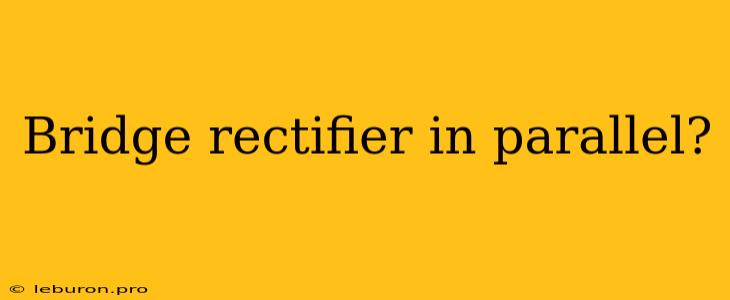Harnessing the Power of Parallel Bridge Rectifiers: A Comprehensive Guide
The bridge rectifier, a fundamental component in electronic circuits, plays a crucial role in converting alternating current (AC) to direct current (DC). While a single bridge rectifier can handle a specific current load, there are situations where the required current exceeds the capacity of a single rectifier. This is where the concept of parallel bridge rectifiers comes into play. By connecting multiple bridge rectifiers in parallel, we can effectively increase the overall current handling capacity of the system, enabling the efficient conversion of high-power AC signals to DC. This article delves into the intricacies of parallel bridge rectifiers, exploring their advantages, considerations, and practical implementations.
The Fundamentals of Bridge Rectifiers
Before diving into the intricacies of parallel bridge rectifiers, it's essential to understand the basic principles behind a single bridge rectifier. A bridge rectifier, as its name suggests, utilizes a bridge configuration of diodes to rectify AC voltage. This bridge configuration allows for the conversion of both positive and negative half-cycles of the AC input into a unidirectional DC output. The four diodes in the bridge are arranged in a specific pattern, ensuring that current flows only in one direction, regardless of the polarity of the AC input.
Why Parallel Bridge Rectifiers?
The primary motivation behind using parallel bridge rectifiers is to enhance the current-handling capabilities of the rectifier circuit. When a single bridge rectifier is unable to handle the required current load, it can lead to overheating, voltage drop, and even component failure. By employing multiple bridge rectifiers in parallel, we can distribute the load among them, mitigating these risks and ensuring reliable operation.
Here are some compelling reasons why parallel bridge rectifiers are often employed:
Increased Current Capacity:
The most significant advantage of parallel bridge rectifiers is their ability to handle substantially higher current loads than a single rectifier. By dividing the current among multiple rectifiers, the overall current handling capacity increases proportionally to the number of rectifiers used.
Improved Efficiency:
Using parallel bridge rectifiers can contribute to improved efficiency in high-current applications. By reducing the current flow through individual rectifiers, we minimize the power dissipation within each rectifier, thereby improving the overall efficiency of the system.
Enhanced Reliability:
Parallel bridge rectifiers offer inherent redundancy, enhancing the reliability of the system. If one rectifier fails, the remaining rectifiers can still operate, ensuring the continuity of the DC output.
Reduced Stress on Components:
By distributing the current load, the stress on individual components within each rectifier is reduced. This leads to longer component life and increased system longevity.
Implementing Parallel Bridge Rectifiers
Implementing parallel bridge rectifiers requires careful consideration of several factors to ensure optimal performance and reliability:
Matching Rectifiers:
It is crucial to use bridge rectifiers with identical specifications, particularly in terms of voltage and current ratings. This ensures that the load is distributed evenly across the parallel rectifiers, preventing overloading of any single rectifier.
Current Sharing:
To ensure proper current sharing among the parallel bridge rectifiers, it is essential to introduce current-sharing resistors or inductors. These components help equalize the current flowing through each rectifier, minimizing the risk of one rectifier carrying a disproportionate share of the load.
Balancing Voltages:
When multiple rectifiers are connected in parallel, there is a risk of voltage imbalances. To prevent these imbalances, it is recommended to use a common voltage reference point for all the rectifiers.
Diode Forward Voltage Drop:
Each diode in the bridge rectifier exhibits a forward voltage drop, which contributes to a slight voltage reduction in the DC output. While the forward voltage drop is relatively small for a single rectifier, it can become more significant when multiple rectifiers are connected in parallel. This is particularly relevant for applications requiring precise voltage regulation.
Applications of Parallel Bridge Rectifiers
Parallel bridge rectifiers find widespread application in various electrical and electronic systems, including:
Power Supplies:
Parallel bridge rectifiers are frequently used in power supplies, particularly those designed for high-power applications such as industrial machinery, data centers, and telecommunications equipment.
Battery Chargers:
In battery charging applications, parallel bridge rectifiers can handle high current loads, enabling efficient and rapid charging of batteries.
DC Motor Drives:
Parallel bridge rectifiers are integral components in DC motor drives, supplying the DC power required to operate the motor.
Electroplating Systems:
Electroplating systems often utilize parallel bridge rectifiers to provide the high currents necessary for depositing metal coatings onto substrates.
Challenges and Considerations
While parallel bridge rectifiers offer numerous advantages, there are certain challenges and considerations to be mindful of:
Synchronization Issues:
In some cases, synchronization issues can arise between parallel bridge rectifiers. These issues can result in unintended current flow between rectifiers, leading to increased power dissipation and potential component damage.
Parasitic Inductances:
Parasitic inductances associated with the wiring and components can affect current sharing, leading to uneven load distribution among the parallel rectifiers. Careful circuit layout and component selection are crucial to minimize these parasitic effects.
Cost and Complexity:
Using multiple bridge rectifiers can increase the overall cost and complexity of the system. Careful design and analysis are necessary to ensure that the benefits of parallel operation outweigh the associated costs.
Conclusion
Parallel bridge rectifiers provide a powerful solution for enhancing the current-handling capabilities of AC-to-DC conversion systems. By connecting multiple bridge rectifiers in parallel, we can increase the overall current capacity, improve efficiency, and enhance reliability. However, careful attention must be paid to factors such as rectifier matching, current sharing, and voltage balancing to ensure optimal performance and avoid potential challenges. As technology continues to advance, parallel bridge rectifier configurations are expected to play an increasingly crucial role in high-power applications, enabling the efficient and reliable conversion of AC power to DC for a wide range of applications.
